There’s a lot to love about winter in Scotland – especially if you love the outdoors. The approach of winter just means that you can switch your “toys” (I mean gear) around and get some old friends out of the garage/cupboard. It’s nearly time to dust off the crampons and get the jumpers out so we thought it was time to remind you of the joys of winter.
Who doesn’t love a fresh coating of snow? It makes everything look clean and sparkly. Many of us (not just the kids) see snow and want to rush outside and make footprints. The arrival of snow brings out the inner child in all of us.
You can now legitimately light the fire and enjoy the warmth as well as the aesthetics.
Top tip though: make sure you have lodes your plenty of fuel inside before you begin, because the last thing you want to do is to leave the cosy warmth indoors to head outside for more fuel.
Need I say more – snowball fights are fun with the right kind of snow and can really be multi-generational.

Bring out your creative streak but if you’re going to go large you’ll find it quite a workout. What’s your preference to make his/her features. We’ve had to sacrifice several carrots.
It’s much more mesmerising than watching the rain and far less wet so it can even be enjoyable to watch the snow fall when you’re out in it so long as it’s not a blizzard and you’re not attempting to drive.
Not something everyone will be looking forward to but those who are in root will be looking forward to taking their sharp, pointy toys out of the cupboard and checking them over ready for the forthcoming season.
Why does snow make the landscape so much more attractive? I think it’s because the white of the snow brings out more contrasts and also makes everything look clean and neat. It’s also because the light is magical for taking pictures.
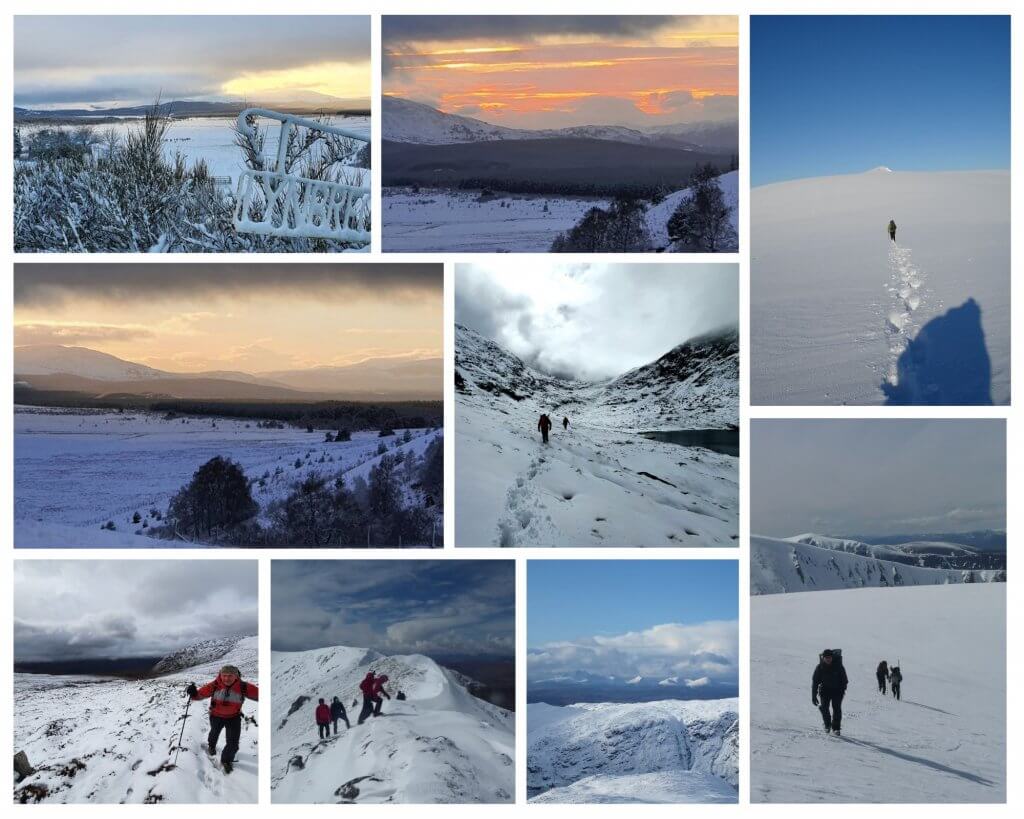
Time to break out all those lovely woolly jumpers.
One of the best things about winter is the lack of bugs, flies and midges.
Frost crystals are quite stunning when you look at them closely.
Look at the image below. Can you believe that all of this is accumulated frost built into the wind from the original structure? This is what the weather station on the top of Cairngorm.
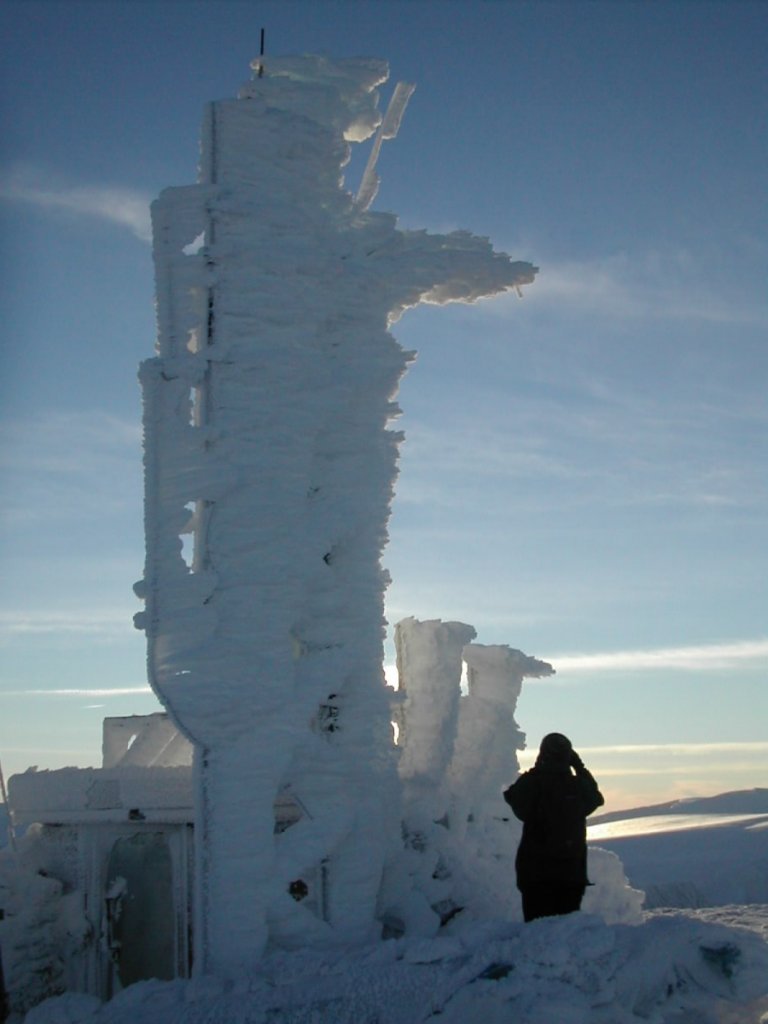
We are so lucky to be living on the edge of ski country. It still surprises us how many people, even those within the UK, who don’t know there is skiing available in Scotland. Yes, we might be suffering from the effects of global warming, but when the weather’s right – a ski day in Scotland is just about paradise.
Ice axe & crampons legitimate adult playing in the snow with sharp, shiny things during winter in Scotland.
When you’re not a kid any more, people tend to frown if you play in the snow. When you’re on a winter skills course, it’s encouraged learn about the snow and ice. You’ll have to slide down a slope with an ice axe, as you’ll need to learn how to stop a sliding fall.
You’ll have to cut holes in the snow, as you’ll need to know how to make emergency shelters – and so much more besides.
Views which stretch for miles are really a thing of winter. The air in summer is warmer and therefore hazier than winter.
Andy has had the privilege of being able to see from Cairngorm to Ben Nevis (55 miles) and has even picked up mountains well to the north all because the cold air is much clearer.
Winter is one of our favourite times of year. We try to keep it to ourselves. It’s not all that hard as so many people seem to be afraid of being cold.
The thing about being out in the winter in Scotland is all it takes is the right level of exercise and the right clothing and you’re sorted.
If you’re worried about it, why not let us be your guides.
One of our clients told us this was the reaction of her daughter when she announced her plans after booking a walking holiday:
“Mum – enjoy your cold, wet holiday with strangers!” implied “rather you than me”
Seriously – this isn’t what it’s like. There’s so much more to a walking holiday.
You know when you join a themed holiday or vacation like this, doing an activity you enjoy, that your fellow guests will be like-minded people. Everyone who books a hiking holiday enjoys hiking – why else would you agree to do it. Therefore you have a common interest to start with. I’ve often overheard people exchanging hiking experiences; finding more and more in common as time goes on.
More often than not it’s more than hiking which you’ll find you have in common with the others. Maybe you share an interest in gardening; or in nature/bird watching; or photography; similar tastes in reading material and the list goes on.
It’s amazing how quickly a few individuals can become a group and thence be friends. Some of our guests have returned year after year to meet up with each other on a trip with us; so much so that we now build some of our trips around them.

Obviously the advantage of hiking every day, is that your fitness levels will improve by the end of the week. Guests quite often feel pretty tired mid-way through the week but by the end of the week, not so much.
You might not notice directly the lack of trees and living green spaces when you’re living in the city; but you might notice that you can get stressed quite easily. It’s really quite phenomenal how much easier it is to relax, to sleep and to be calm it is in the countryside. Certainly we receive quite a few comments about the lichens on the trees (indicating the purity of the air here); people notice because it’s not the same where they live.
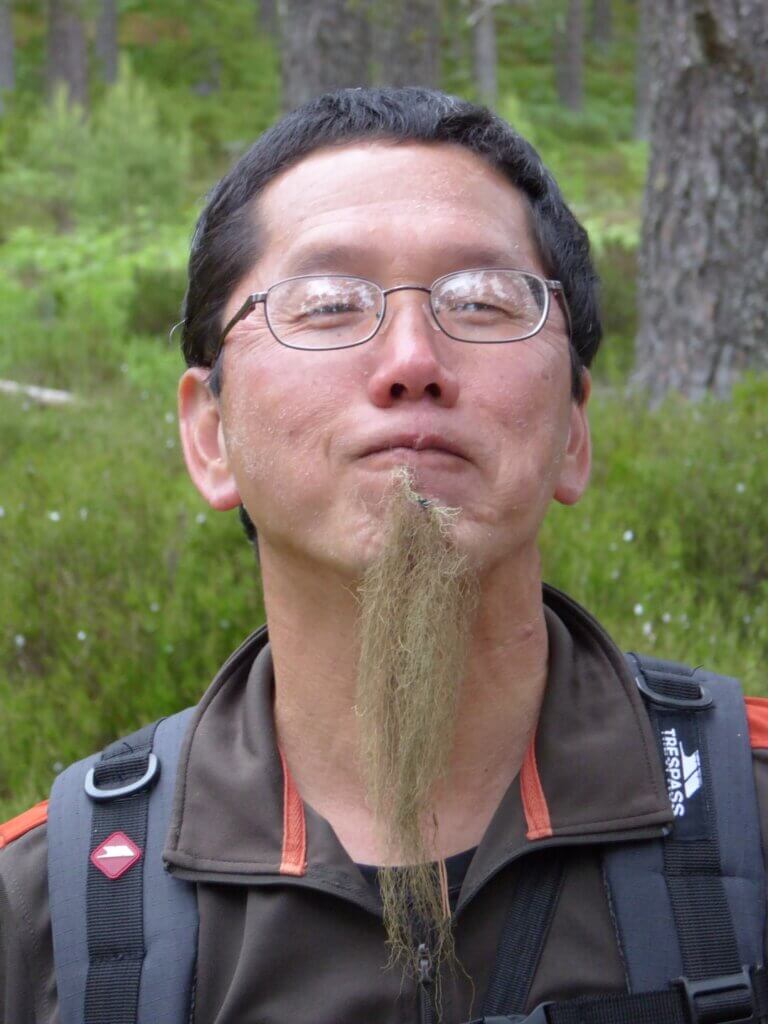
Playing with lichen
Walking is not only a fantastic form of exercise but also a natural mood enhancer. A guided walking holiday encourages participants to embrace the great outdoors, providing a perfect balance of physical activity and mental relaxation. The rhythmic pace of walking is known to reduce stress and promote overall well-being.
When you’re outside, engaging in a physical activity, whether it’s hiking or kayaking or climbing, this totally engages your body and mind. There is no space left for worrying about work or home life concerns. We’ve taken hiking breaks before which have been little more than 24 hours, only one night away from home, but they’ve felt like a week away. It’s felt totally refreshing and ready to get back to work.
It’s a simple formula but it works. Somehow taking life back to these simple but essential tasks (especially when someone else is doing the cooking and cleaning) makes for a very relaxing holiday.
There are 2 kinds of tired: stressed tired and happy tired. When you’ve been out hiking all day, your body is physically tired but your mind is relaxed. Hence when you go to bed, you tend to sleep like a log.
Travelling at walking speed means that you have plenty more opportunities to spend time with local people. If your trip is also guided then your guide/travel experts will have curated the best places and people for you to meet.
One of the primary advantages of a guided walking holiday is the expertise of the tour guides. These knowledgeable professionals not only ensure your safety but also enhance your experience by sharing insights into the local history, flora, and fauna. Their presence adds depth to your journey, turning a simple walk into an educational and engaging adventure.
Walking is an eco-friendly mode of travel that minimizes your carbon footprint. Guided walking tours often emphasize sustainable practices, promoting responsible tourism and a deeper appreciation for the environment.
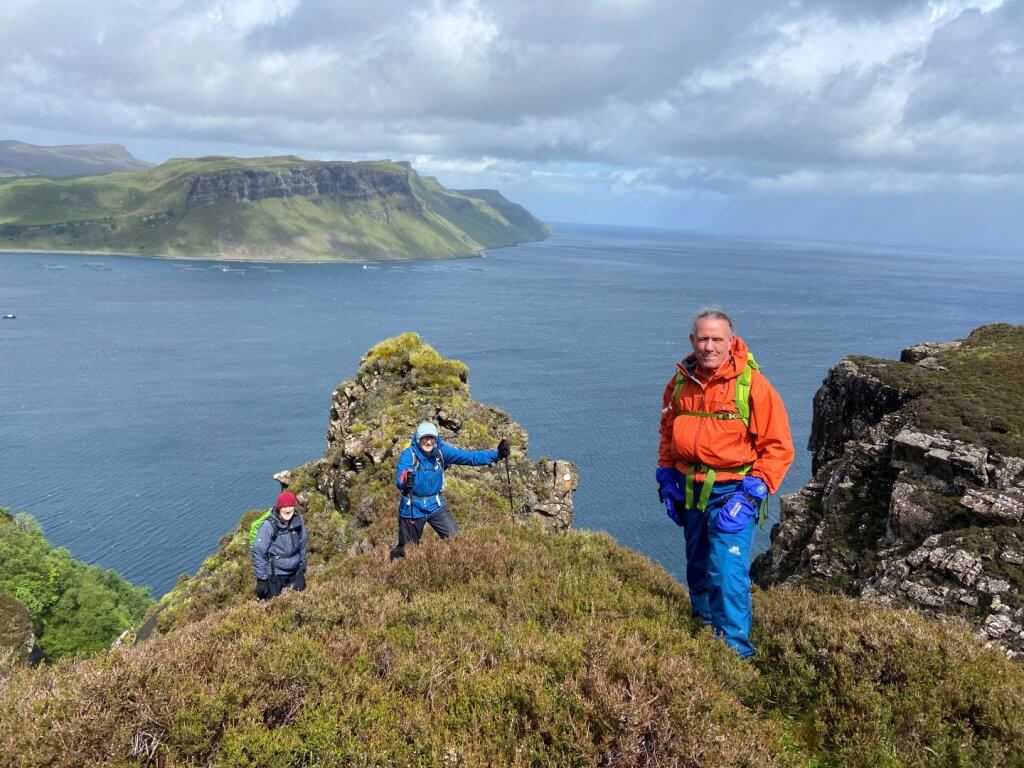
In conclusion, booking a guided walking holiday is an invitation to slow down, engage with the world on a more intimate level, and savor the beauty of each step. These journeys not only nourish your body and soul but also leave you with a newfound appreciation for the diverse landscapes and cultures that make our world so extraordinary. So, lace up your walking shoes and embark on a guided walking holiday – a transformative adventure that promises to be as enriching as the destinations themselves.
From the Inverness Courier
Iain said: “If you’re anything like me, and you go to the gym, I would do 20 minutes and say that’ll do, I’m away up the road – but when you go and climb a Munro, for instance, you can’t stop until you reach the top. Then you’ve got to head back down, so the physical benefit is immediate. (Read on…)
Benefits of a guided walking holiday
Exploring the mental health benefits of being in the outdoors
We’re busy pulling together the final details for all our winter Munro walking trips, including a planned return to the Glencoe area. Despite not having written the prose to promote this itinerary we do already have bookings so best to express your interest as soon as possible.
We are delighted to announce our new, revised itinerary for our Winter Munros trip in Glencoe. We will again be based at River Mill Cottage and will be following the itinerary below as closely as the weather allows:
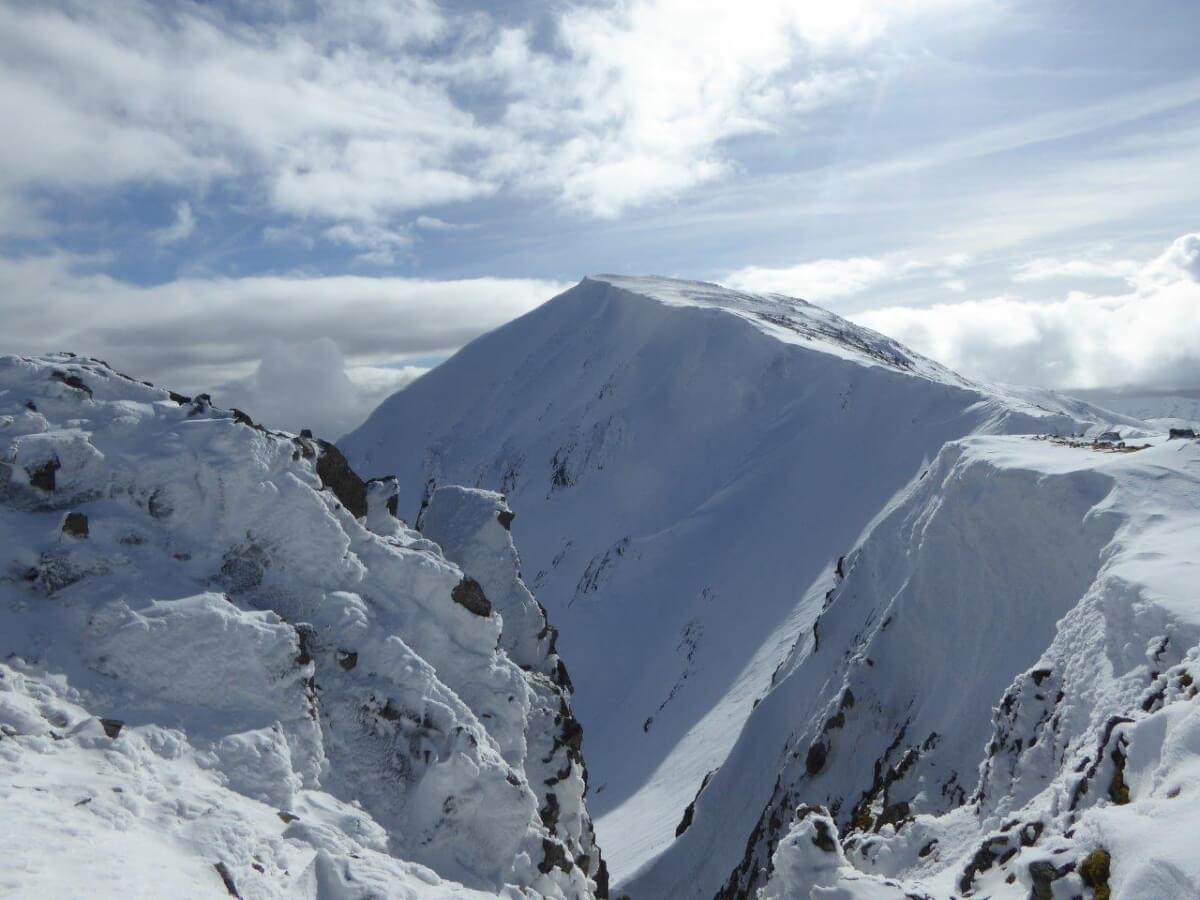
We have been in the Glencoe area before and have designed other itineraries for previous groups. Please do feel free to check these out in the private groups section, but bear in mind that in order to run one of these other itineraries for you we will need plenty of notice in order to arrange accommodation for your group and make sure that there is availbility for your proposed dates. Ideally we would plan a private group tour at least 6 months in advance.
Please bear in mind that since the Covid pandemic it has become increasingly difficult to book accommodation in remote areas with limited options.
there are trails all round the area plus several centres with purpose-built tracks like Laggan Wolftrax and Glenlivet Bike Trails. Bikes can be hired from Mikes Bikes or Bothy Bikes in Aviemore.
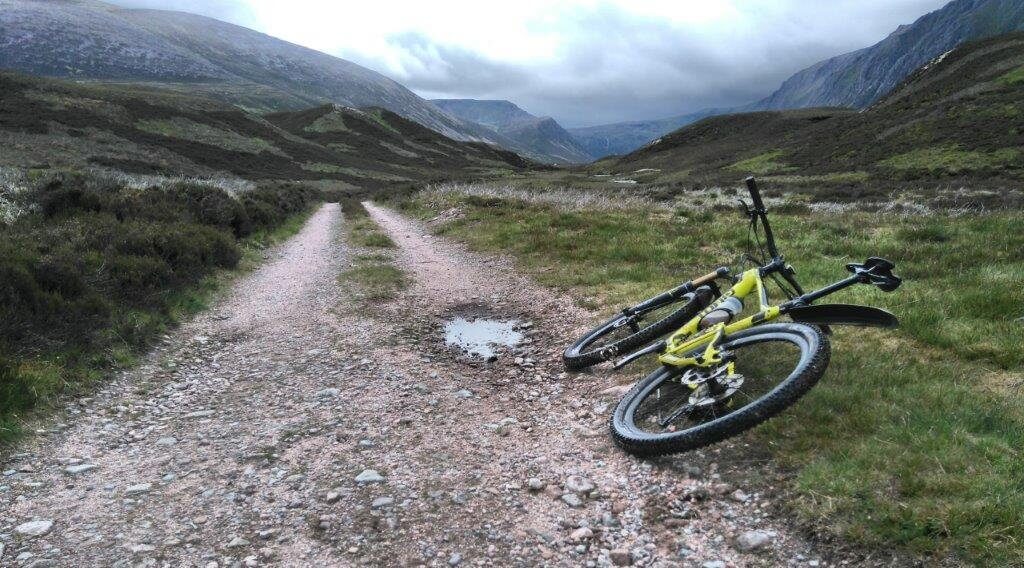
Enjoy the wild parts of the UK out on your bike
with G2 on the Alvie Estate.
Aviemore has a community ice skating rink again and you can also use the all weather rink at Loch Insh
you could take the public bus to Boat of Garten (5 miles) or Nethybridge (8 miles) and walk back to Aviemore stopping in the Old Bridge Inn for a pint on your return.
and paddle the Spey;
canoe with the Moray Firth dolphins or kayak/canoe on Loch Ness.
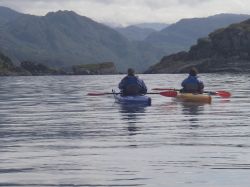
Water based options might not be as appealing as you think, but water is surprisingly warm in the winter.
a tour to Loch Ness is a popular option for our guests at Fraoch Lodge
and check out the Findhorn Foundation or visit the Kimberley Inn for lunch and walk along the white sands of the beach.
and try out ice skating.
unfortunately the Aviemore pool at the Macdonald’s resort is not currently available to the public for swimming.
and tour a distillery plus visit the Cooperage
Always a wet or cold day option – a distillery visit or whisky tasting.
or Johnston’s wool mill in Elgin if Knockando is closed. Tours are every hour until 3 or 4pm and are free of charge.
where you can experience the whole wool story from shorn fleece to completed material.
Get crafty if you’d like some time and space to knit, ask Rebecca for recommendations
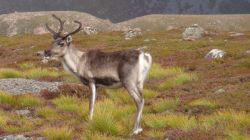
If you like to see reindeer, you should come to Aviemore, particularly in the winter which is their natural habitat.
and/or the Highland Folk Museum
Traditional village which is part of the Newtonmore Highland Folk Museum
New website for the Cairngorms National park highlighting selected experiences within the park – cairngormsnationalpark.co.uk
Arran delivered in spades for our guests this year. We had an amazing week at a stunning cottage in Blackwaterfoot, despite the logistical nightmares of organising the trip this year which included ferry hiccoughs galore.
Andy and the guests explored some stunning geological features and coastal walks and despite having been over to Arran before (more than once) we still found new spots to explore.
Below are the posts Andy made on Facebook summarising the fabulous days out they had.
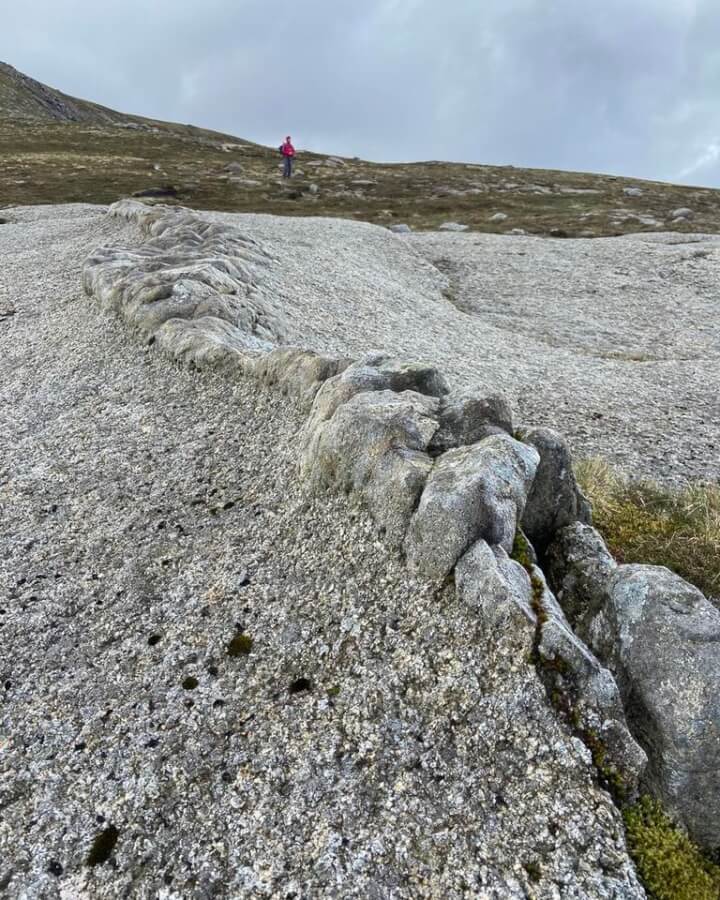
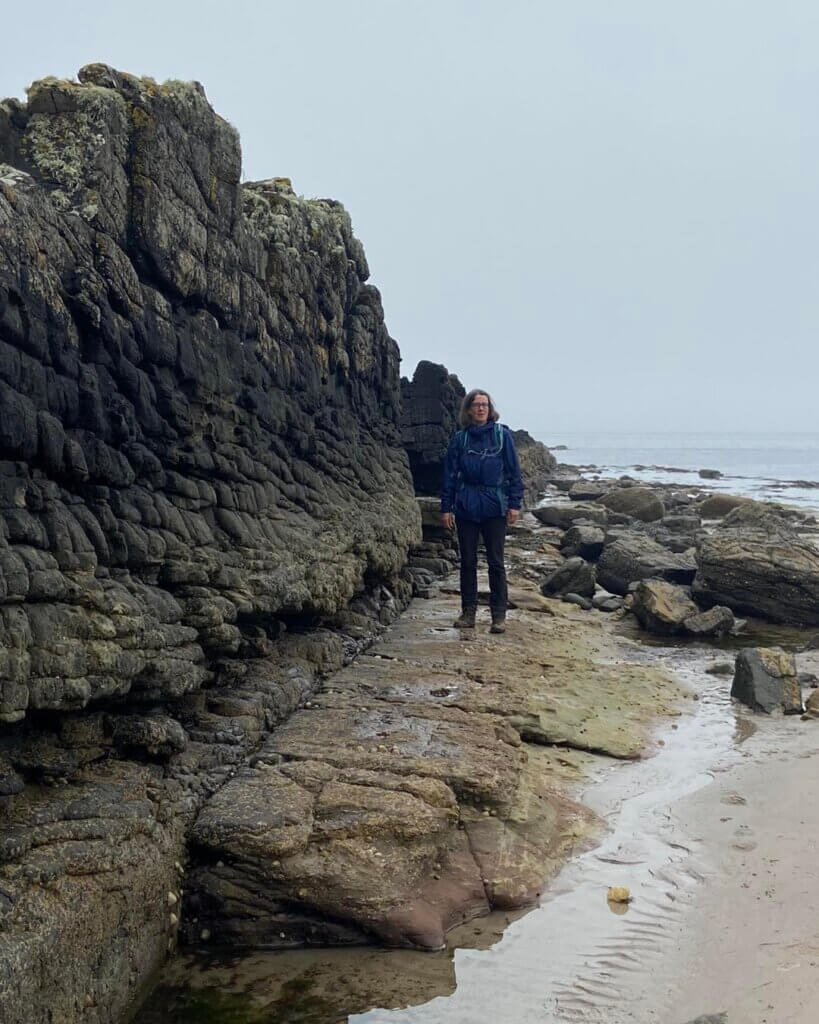
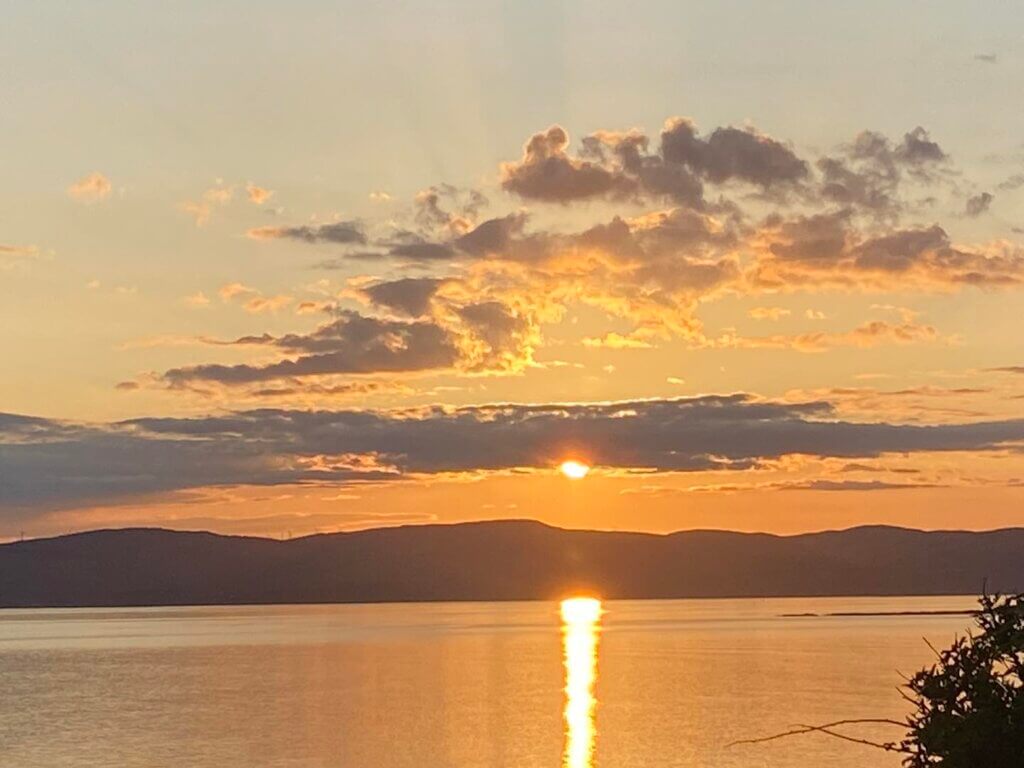
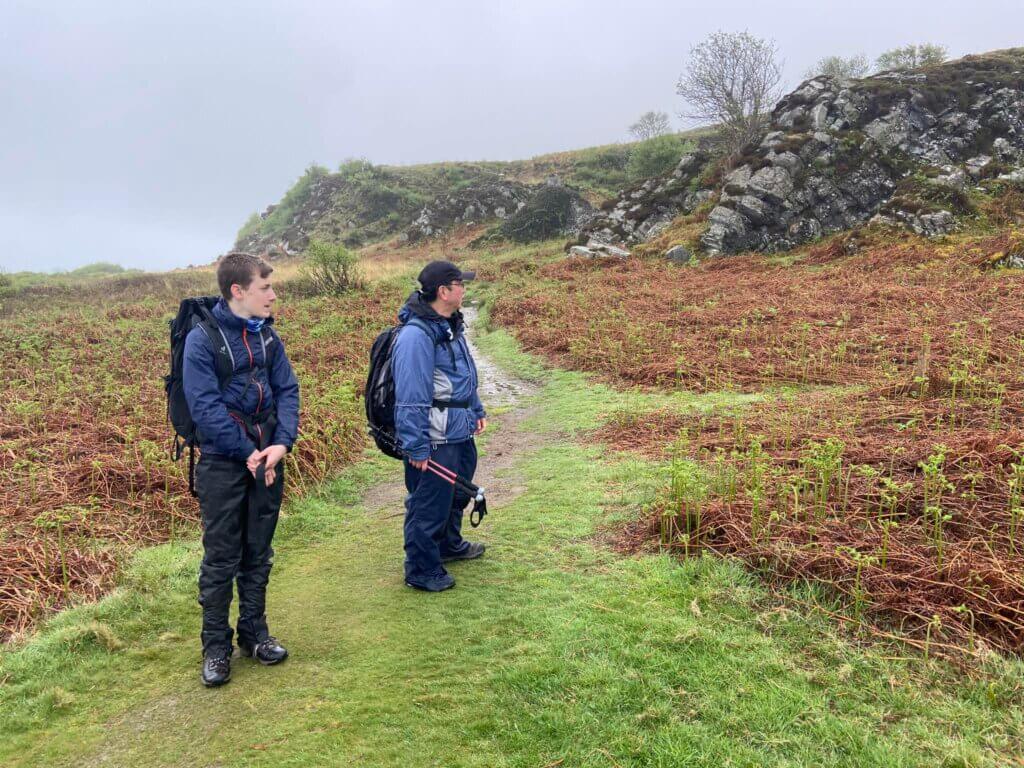
A quick album from our Skye Munros trips in 2022 – Skye Black Cuillin Munros (excluding climbing gallery) and Skye Black Cuillin for Hillwalkers, based in Portree.
If you’re considering joining us in 2o23, places are already limited (one place remaining) on the climbing itinerary. Take a look at the images below for an idea of what to expect when you join us next year. As you can see the weather wasn’t always perfect, but there still seem to be lots of smiling faces even if the jackets, hats and gloves did come out on occasion.
Portrait images will not display in the gallery except in landscape format which makes them awkward to view so they are only displayed in the gallery where they are displayed correctly.
For full versions of the images please check out this link to our google album.
Walking holiday options on the west coast of Scotland are almost endless. Knoydart or Skye – where to go? One of the most popular and endlessly filmed locations is the Isle of Skye. The dramatic jagged images of the Skye hills have formed the backdrop for many a dramatic movie. However, there are places which are just as satisfying to walk all up and down the west coat where the views are as magnificent or even more stunning. We’re heading over to Skye and to Knoydart in May this year. See our assessment here of the advantages and disadvantages of each to help you make a decision.
Skye has a huge reputation as a destination in Scotland based on the dramatic nature of its scenery and its romantic attachment to the Stuart/Jacobite legend. The attraction of Skye for hillwalkers and Munro baggers comes from the nature of its terrain. There is nothing to match the jagged peaks of Skye in the UK. The closest comparable peaks are in the Alps, when you may also have to contend the the altitude and the additional possible complication of altitude sickness.

Topping out on the Innaccessable Pinnacle in glorious sunshine weather, Skye May 2016
Skye is more accessible. The bridge over to Skye has made it much more accessible to everyone, especially now there is no toll. However, it has also taken away a small part of the mystique which comes from taking a ferry to get somewhere; it makes you feel more like you’re going somewhere exotic and unknown, almost as if you’re abroad. That’s now missing from the Skye experience (unless you choose to take a ferry route or are island hopping through the Hebrides), but is still a part of going to Knoydart
To reach the actual Munro summits on Skye you will need to do some roped climbing. It is the ambition of many a Munro bagger to reach the top of the Innaccessible Pinnacle. Some will never make it as you do need to have some elementary rock climbing skills and a very good head for heights (see Skye photos below)
Knoydart is only accessible after a boat ride from Mallaig or a long walk in along the peninsula. There is no motorised transport allowed on the peninsula for visitors i.e. you can not take your car there. It still has the feel of being remote and inaccessible. You feel privileged to have the opportunity to visit. Even the public ferry is a relatively small boat but most groups end up chartering wee motor boats to get down the loch to Inverie.
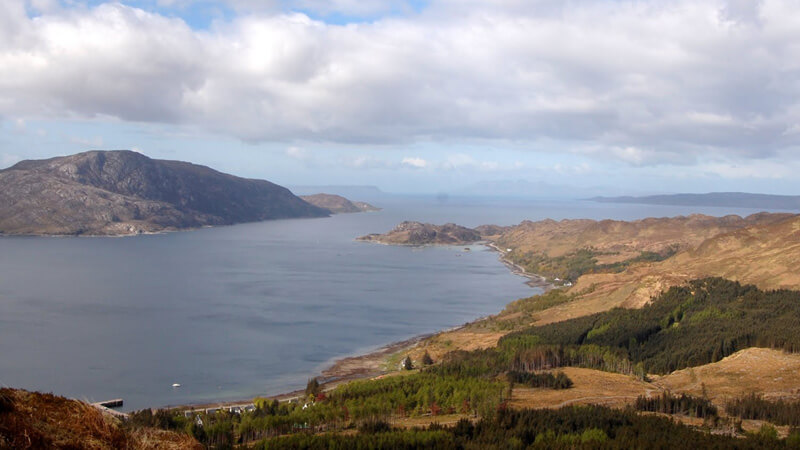
Loch Nevis looking towards the islands of Eigg and Rhum
All the peaks in Knoydart are accessible to a walker without the use of ropes.
You can see the Cuillin Ridge clearly from Knoydart while climbing the peaks there.
Both have excellent dining opportunities, especially if you like seafood.
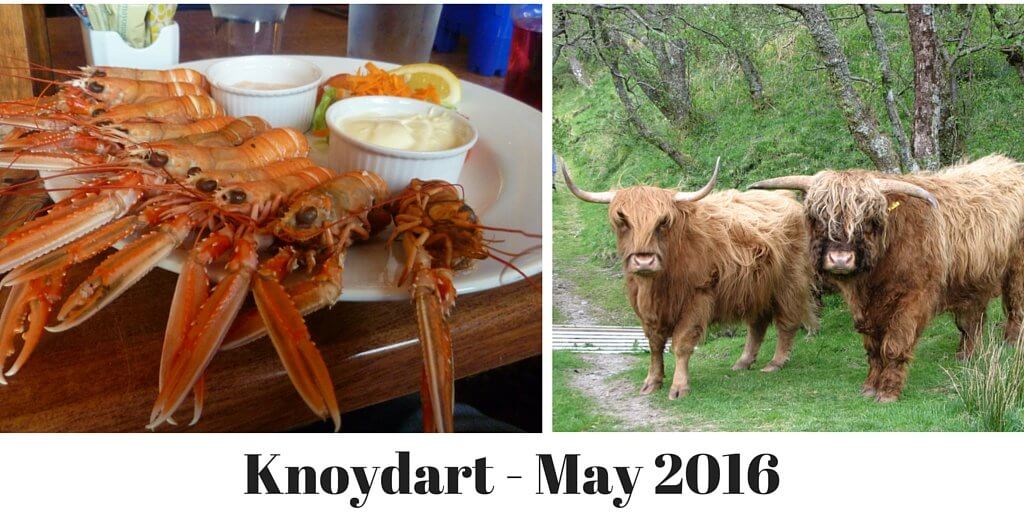
See our pictorial comparison below:
We’ve chosen 3 images from our Skye collection. They certainly give you an idea of the kind of terrain which makes up the ridge. If you’re on social media (and connected to the right people, which includes us!) you might have seen the famous film of Danny Macaskil riding his mountain bike along the ridge. In fact, you don’t even need to have been on social media as a short programme about the making of the film was shown on BBC TV.
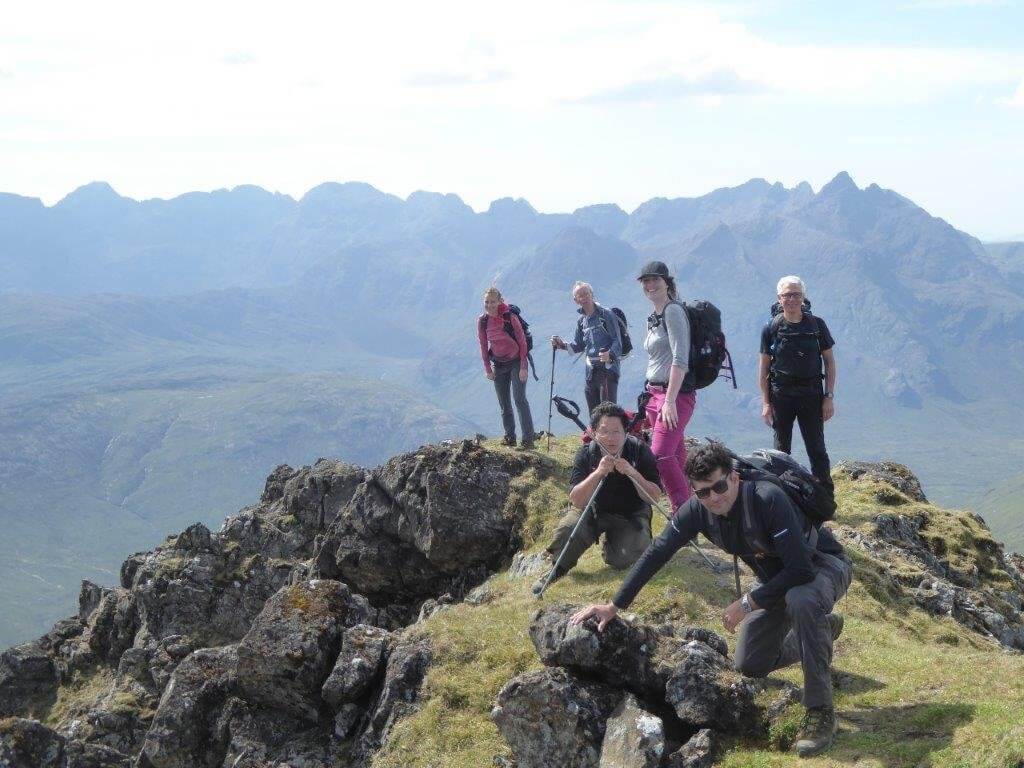
High in the Cuillin mountains of Skye
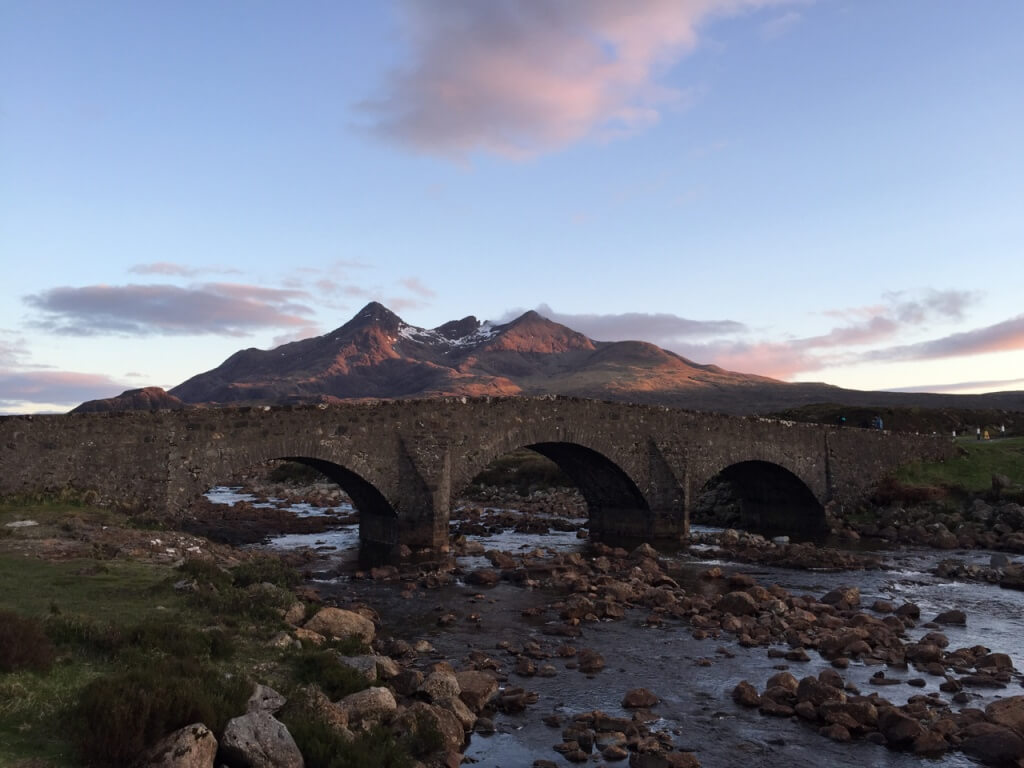
Sunset over Am Basteir from Sligachan on the Isle of Skye during the Skye Munros itinerary
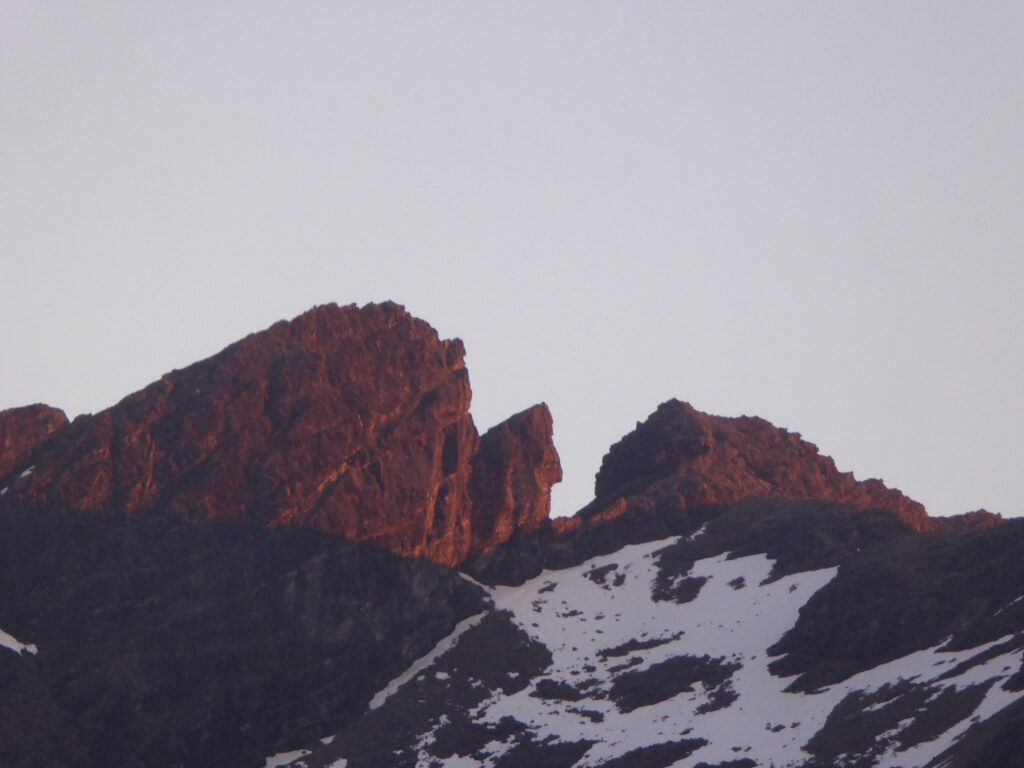
Sunset over the Cuillin hills in Skye
Britain’s most remote wilderness (on the mainland) – Knoydart does have a very special feel to it.
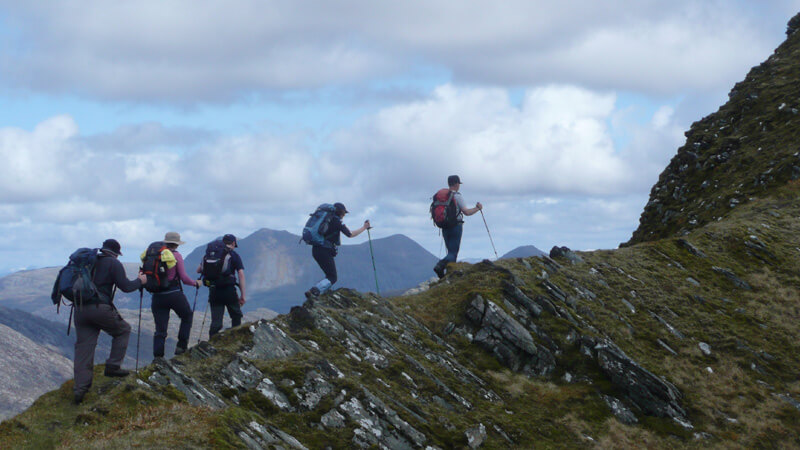
The ridges of the Knoydart peaks

Eve negotiates the ridge
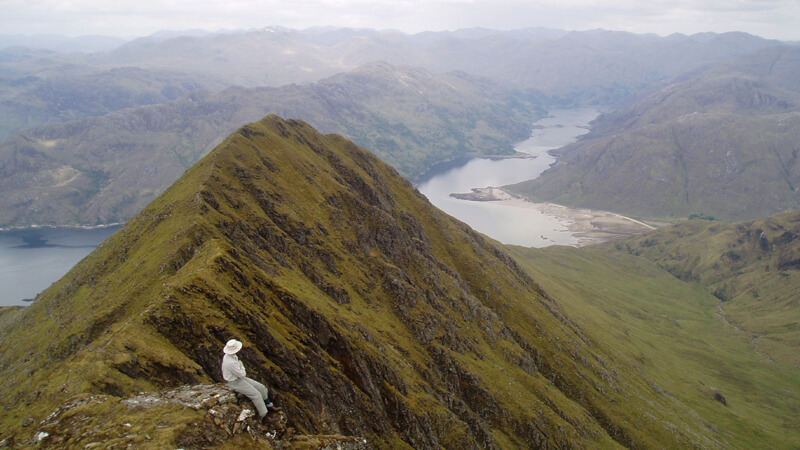
Mick admiring the view in Knoydart
Knoydart:
The Knoydart Foundation – http://www.knoydart-foundation.com/
The Old Forge, Britain’s most remote pub – http://www.theoldforge.co.uk/
Britain’s most remote wilderness in video – http://www.theguardian.com/travel/video/2013/jun/11/britain-wilderness-scotland-knoydart-peninsula-video
John Muir Trust in Knoydart – https://youtu.be/rGCL7uBRw5s
Skye:
Walkhighlands: The Black Cuillin
TripAdvisor: The Black Cuillin http://www.tripadvisor.co.uk/Attraction_Review-g186585-d196763-Reviews-Black_Cuillin-Isle_of_Skye_The_Hebrides_Scotland.html
Black Cuillin Ridge of Skye – http://www.mountainhiking.org.uk/scotland-mountains/skye/skye4.shtml
Danny Macaskill – The Ridge – https://youtu.be/xQ_IQS3VKjA
The Munro Show – Sgurr nan Gillean https://www.youtube.com/watch?v=Lfc-dDsfV6c
Our Highland Wilderness Glamping trips have really caught the imagination and produced some amazing images.
We asked Scottish Field and Trail magazine if they’d like to come along and join us to help spread the words. Both magazines sent teams to join us for a full-on Highland Wilderness Glamping Experience, producing the articles below. You may have seen them in the magazines if you’re a subscriber.
If you’re considering joining us on an adventure with the ponies, have a read and let us know what you think.
Back to: Highland Wilderness Glamping Adventure
Back to: Highland Wilderness Glamping Taster
Back to: Highland Wilderness Glamping Adventure
Back to: Highland Wilderness Glamping Taster
In fine summer conditions wild camping, in the UK can be a glorious experience. As a youngster, a high wild camp in the mountains was one of the most wholesome, formative and enjoyable experiences of my life, and still is.
For a large chunk of the year though, a wild camp can often end up being an experience that’s endured rather than enjoyed. Along with the sun loosing its summer strength goes its ability to appreciably warm and reduce the humidity of our damp maritime air as it moves inland. By Day 2 of any multi-day trip, that pervasive damp has invariably got into your gear. Worse, if any of your gear gets wet at this time, the only realistic chance of drying it is to wear it!
Without any risk of exaggeration, adding a camp wood burner to your tent is a COMPLETE and UTTER GAME CHANGER! This isn’t something new. The indigenous people of the Arctic have been doing it since time beginning. What is new is the availability of camp wood burners in the UK.
With the stove we use, it’s quite possible, whist having an outside temperature close to freezing, to basking in 25 degrees of heat inside!
With a smaller tent and a larger stove, the Ray Mears boast of 28 degrees C inside whilst the outside temperature is minus 35 degrees becomes entirely believable! (start at 4:30 in if you’re pushed for time).
This elevated temperature has the effect of substantially reducing the relative humidity of the air and the prospect of being able to banish that damp.
Combining a camp wood burner with a tent or teepee made of a naturally breathable poly-cotton canvas creates a remarkably dry atmosphere. Even to the point that the upper surface of a ground sheet in contact with cold ground will readily dry!
A teepee style tent gives a wonderful drying area in its upper reaches, the apex. It is, of course, the warmest part especially with the flue pipe going straight up through the centre.
In the depths of winter, if you’re able to keep the stove in over night it is quite possible to have dry gear by the morning, and that includes boots! A wood burner raised adequately up off the ground allows boots to be placed under it without drying the leather out too aggressively.
For us the “après” adventure, the evening meal, etc has always been an important part of the whole experience. The central camp stove provides a wonderfully cosy focal point around which guests can sit, relax and enjoy each others company. Often the only adequate cosy alternative when using conventional camping gear is to cocoon yourself in your sleeping bag.
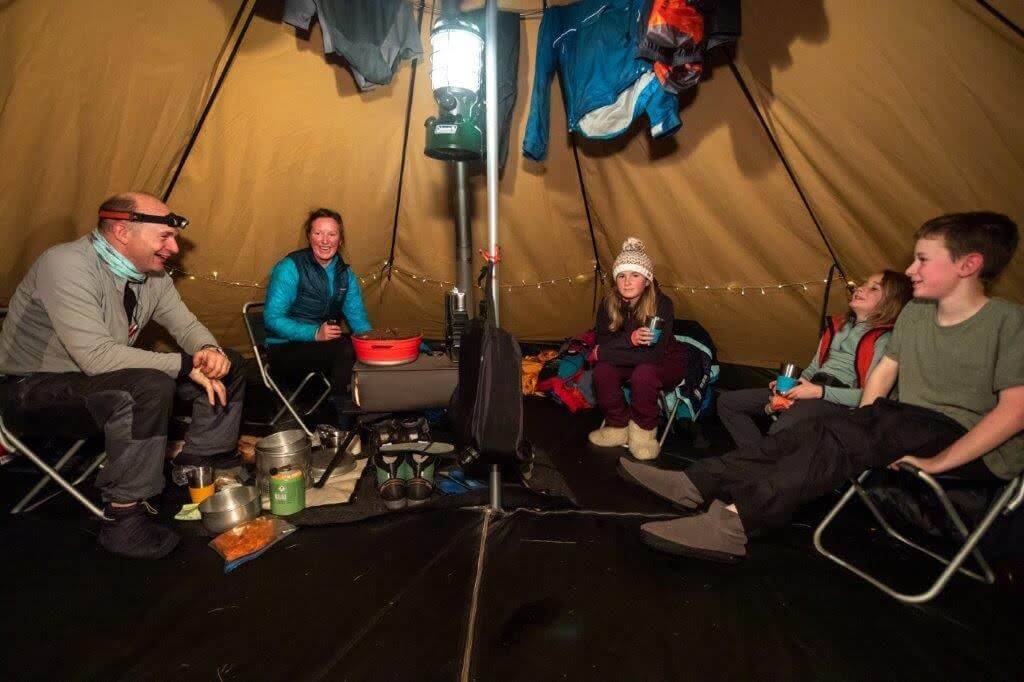
Deadwood is a very important part of any woodland ecosystem, especially so in nature conservation areas, It’s the food of fungi, larvae, etc that then in turn feed other wildlife species. This should be born in mind when sourcing wood and if necessary fuel should be taken with you. It is also worth bearing in mind that deadwood is the legal property of the landowner.
Depending on the time of year it may be difficult to find dry wood in the wild. As is the case with burning any damp or “green” wood, a lot of heat energy is lost in the form of latent heat evaporating the water rather than it raising the temperature.
Make sure you take extra care to dispose of any ashes and cinders safely. You need to be super careful when wild camping to avoid any risk of starting a wild fire.
If you’d like to try hot tent camping, before investing in all the gear yourself you might want to consider this trip: Hot tent camping with Scot Mountain Holidays
We’re bringing out another trip soon based on the isle of Rum in early April and hot tent camping for the duration. Keep an eye on the website for details.
It’s not easy to know what to pack for a new type of vacation, especially if you’ve got a longer holiday planned. You want to make the most of your trip though so always a good idea to have a check list of things you really don’t want to forget. It’s also nice to know what you don’t need to pack, if some of the gear is being provided for you then that takes the pressure off your bags.
We’ve put together the ideal kit list of the wilderness glamping trips just so there isn’t anything vital that you forget to bring because it’s not like you can stock up while you’re out on the adventure: there aren’t any stores around.
You might be surprised to find that you there’s little or nothing you need to buy to come on this trip. Hint: All the camping/glamping gear is provided by Scot Mountain Holidays.
All content © Copyright Scot Mountain Holidays 2025
Responsive web design by Summit Web Solutions